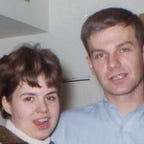Family Tree Part 2
Baseball writers, especially those who stray beyond stats and play-by-play, sometimes venture into philosophy as they seek a way to explain why they spend their adult lives on a kids game. It's “a continuity through the ages,” one said, “a bridging of generations. We join hands with the long line of forefathers and with the dead.”
That may sound a bit pretentious, but those writers don’t have to convince us. Every generation of Kladstrups has picked up a bat, hit a ball, then run the bases feeling the ghosts of family beside them. Even today, nearly a century and a half after the first Kladstrup run was scored, baseball provides links among the far-flung family.
Grandpa Peter Kladstrup and his brothers began playing on their Iowa farm when the ink on the pages of the “Knickerbocker Rules” was still wet.
They had barely disembarked from the ship bringing them from Denmark when the boys carved out their baseball diamond in a corner of one of their pastures. "If it's wet, we said spread it around," Grandpa recalled. "If it's dry, make it second base." With his brothers and neighbours, they formed the East Newell team. There was no such place as East Newell, but their farms were east of Newell, Iowa, so they stitched the letters "E" and "N" onto their jerseys.
It was a distant cousin whom we barely knew at the time who discovered the old photo at his late mother’s house in Texas. He got our address in France through the family grape vine and sent it to us because “I know Don likes baseball.”
Aunt Carol, Grandpa’s youngest child, found her Dad’s jersey when she and her husband Gale cleaned out the family home in Iowa. “When Gale tried to pick up Dad’s pants, they just crumbled; the moths had found them. But the shirt was still almost perfect,” she wrote when she sent the jersey to us.
In the dark days of the Depression, there wasn't much to hand down to their children, but a love of baseball was one thing that passed easily to the next generation. Grandpa's sons, including Don’s Dad, played with the same enthusiasm as their forebears. There do not seem to be any photos of his Dad playing baseball as a young man, but a younger neighbour remembered, "He was a damned good pitcher; went to the state tournament. A real athlete. All of us younger guys looked up to him and his friends. We wanted to be just like them."
Any baseball dreams his Dad may have had were firmly surpressed in the hard times. But he went to work for Eastman Kodak, so he was able to capture his younger brother Arlo on the field. He noted on the back of the photo, "Arlo, playing baseball, with a wonderful smile." Don’s brother Steve discovered the picture in their parents’ house in Rochester, NY.
And so, it was down to our generation to pick up the ball, and Don did so enthusiastically from a young age. They were living in Hawai'i then, and Don’s Dad was playing with the Kodak Hawai'i softball team. Don, who was 5 or 6, was playing a street variation of the game he called "Sky Inning." He'd throw the ball against the curb, let it bounce up and try to hit it to the "out fielder."
It was good practice for the Little League teams he got to play with when they moved back to Rochester. His Dad helped coach. He was thrilled; this was real baseball and the best part of it was getting onto the mound and pitching.
In high school, He got really good. How he loved to strike those guys out and pick them off at first! He had a natural curve, his coach said, and he reported Don was doing well enough that scouts from a couple of major league teams were looking at him.
Don could hardly sleep thinking about that. Grandpa, he was later to learn, had much the same reaction; he loved hearing about Don’s baseball successes, Aunt Carol said. Meanwhile, Don’s Dad hung a bulletin board labeled “Kladstrup Klips" above his desk and pinned on newspaper articles about his games.
A pop in Don’s shoulder during some pull-ups, however, ended his "career" and he went back to being a full-time fan, maybe loving the game all the more knowing he couldn't play it the way he'd dreamed.
His love of the game communicated itself to our daughters, though, and Don was soon to be cheering from the sidelines, this time in Los Angeles where he was cheering especially that Little League was opening to girls.
As for baseball in the future for Kladstrups, well, who knows? We’re now in France, but it won’t be for a lack of trying, though. Younger daughter Kwan Li brought grandson Aaron to watch Don play with the Honfleur Comets in Caen in Normandy. Aaron was the most enthusiastic one in the dugout.
Kwan and Aaron live in Haiti now, but the links of family and baseball have reached much further than that for generations — from Denmark to Iowa to Hawai’i, back to New York, Texas, California and on to France.
We can feel the roots of the family and game growing deeper every day. A bridging of generations, for sure. But more. Through baseball, we have, indeed, “joined hands with a long line of forefathers and with the dead.”
